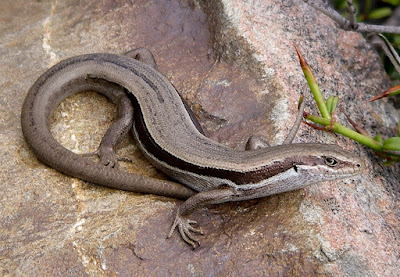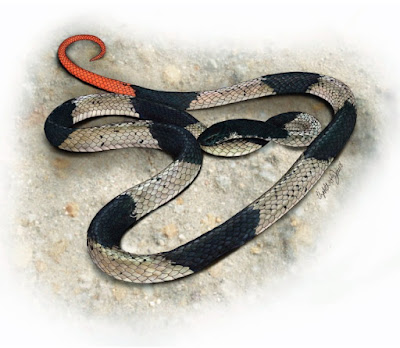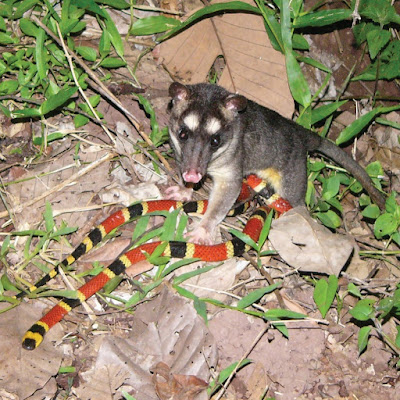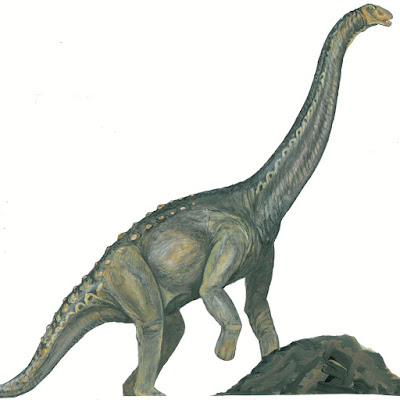[Most Recent Entries] [Calendar View]
Thursday, February 1st, 2018
| Time | Event | ||||||
| 2:25a | [Herpetology • 2018] Oligosoma hoparatea • A New Species of Scincid Lizard in the Genus Oligosoma (Reptilia: Scincidae) from the mid-Canterbury high country, New Zealand
Abstract New Zealand has a diverse, endemic skink fauna, which is recognised as the most species rich skink assemblage of any cool temperate region on earth. All native New Zealand skink species are assigned to a single genus, Oligosoma Girard. A new species of Oligosoma is described from screes in montane tussock grassland in the mid-Canterbury high country, New Zealand, where it is currently known from four sites on two mountain ranges. The new species (Oligosoma hoparatea sp. nov.) can be distinguished from all congeners by a combination of mid-body scale row and lamellae counts, scale morphologies, and a bold striped pattern with smooth-edged, dark lateral bands. It is part of the O. longipes Patterson species complex, and occurs in sympatry with its closest relative, O. aff. longipes ‘southern’. The species is currently highly threatened, and is listed as Nationally Critical in New Zealand. Predation by a suite of introduced mammals is assumed to be a major threat to its survival. Keywords: Reptilia, Conservation, Oligosoma hoparatea sp. nov., morphology, taxonomy Tony Whitaker, David G. Chapple, Rodney A. Hitchmough, Marieke Lettink and Geoff B. Patterson. 2018. A New Species of Scincid Lizard in the Genus Oligosoma (Reptilia: Scincidae) from the mid-Canterbury high country, New Zealand. Zootaxa. 4377(2); 269–279. DOI: 10.11646/zootaxa.4377.2.7 | ||||||
| 3:10a | [Herpetology • 2018] Calliophis salitan • A New Species of Long-glanded Coralsnake of the Genus Calliophis (Squamata: Elapidae) from Dinagat Island, Philippines, with Notes on the Biogeography and Species Diversity of Philippine Calliophis and Hemibunga
Abstract We describe a new species of coralsnake from northern Dinagat Island, southeastern Philippines. The discovery of this new species comes as a surprise because it is phenotypically distinct from all other Philippine coralsnakes and has a close phylogenetic affinity to the blue coralsnakes of the Sunda Shelf. The new species is distinguished from all Philippine and other Southeast Asian taxa by its large body size and ventral scale counts; its black head and neck; an alternating, broadly banded color pattern of black and off-white; and a bright orange tail. We use DNA sequence data to investigate the phylogenetic placement of the new species and that of several other populations of Philippine coralsnakes with respect to other Southeast Asian and Australasian elapids. Our results corroborate the uniqueness of the new species with respect to all other Philippine and Sundaic taxa, including the species most closely related to it: Calliophis bivirgatus, C. bilineatus, C. philippinus, and C. suluensis. We summarize phylogenetic, biogeographic, and phenotypic character data that substantiate the elevation of Philippine species of Calliophis (formerly considered subspecies of C. intestinalis: C. bilineatus, C. philippinus, and C. suluensis) and Hemibungarus (formerly subspecies of H. calligaster: H. calligaster, H. gemianulis, and H. mcclungi) to the level of full species. The allopatric distributions of these taxa emphasize the systematic and biogeographical significance of the newly discovered taxon: a poorly understood and independent colonization of the Philippine Archipelago by elapid snakes. Keywords: Calliophis salitan, Caraga Region, Mindanao PAIC, new species, false coralsnakes
Calliophis salitan sp. nov. Etymology.— The specific epithet is a noun in apposition and is derived from the Tagalog (Filipino) term salitan, meaning‘‘alternating,’’in reference to the distinctive, alternating black and off-white banded color pattern characteristic of the new species. Suggested English common name: Dinagat Island Banded Coralsnakes. Habitat, distribution, and natural history.— The only known locality for Calliophis salitan is the low foothill of Mt. Cambinlia, Barangay Santiago, Municipality Loreto, Dinagat Island (Fig. 8), Philippines, where it was collected from an elevation of 195 m. This locality, dominated by selectively logged, regenerating second-growth forest, is situated at the northern end of the island, and has a tropical climate, with a mean annual precipitation of 3580 mm (recorded at Loreto town proper,,1 km from the type locality; higher precipitation values are possible at higher elevations on Mount Cambinlia). Precipitation is highest during December (~539 mm) and lowest in August (averaging 143 mm),and the mean annual temperature is 278C. The type specimen was collected between 1900 and 2200 h, and was actively crawling along a stream bed with reduced water flow between intermittent pools. The specimen was obtained at the end of July, toward the end of the dry season. Rafe M. Brown, Utpal Smart, Alan E. Leviton, and Eric N. Smith. 2018. A New Species of Long-glanded Coralsnake of the Genus Calliophis (Squamata: Elapidae) from Dinagat Island, with Notes on the Biogeography and Species Diversity of Philippine Calliophis and Hemibungarus. Herpetologica. In-Press. DOI: 10.1655/Herpetologica-D-17-00008 | ||||||
| 3:44p | [Mammalogy • 2018] A Revision of Philander (Marsupialia: Didelphidae), Part 1: P. quica, P. canus, and A New Species from Amazonia ABSTRACT This is the first installment of a revision of the didelphid marsupial genus Philander, commonly known as gray four-eyed opossums. Although abundant and widespread in lowland tropical forests from southern Mexico to northern Argentina, species of Philander are not well understood taxonomically, and the current literature includes many examples of conflicting species definitions and nomenclatural usage. Our revision is based on coalescent analyses of mitochondrial gene sequences, phylogenetic analyses of mitochondrial and nuclear genes, morphometric analyses, and firsthand examination of relevant type material. Based on these results, we provisionally recognize eight species, of which three are formally treated in this report: P. quica (Temminck, 1824), an Atlantic Forest endemic formerly known as P. frenatus (Olfers, 1818); P. canus (Osgood, 1913), a widespread species formerly treated as a synonym or subspecies of P. opossum (Linnaeus, 1758); and Philander pebas, a new species endemic to Amazonia. The remaining, possibly valid, species of Philander can be allocated to two clades. The first is a cis-Andean complex that includes P. andersoni (Osgood, 1913); P. mcilhennyi Gardner and Patton, 1972; and P. opossum. The second is a trans-Andean complex that includes P. melanurus (Thomas, 1899) and P. pallidus (Allen, 1901). Among other nomenclatural acts, we designate a neotype for the long-problematic nominal taxon Didelphis superciliaris Olfers, 1818, and (in an appendix coauthored by Renate Angermann), we establish that Olfers' coeval binomen D. frenata is based on an eastern Amazonian type and is a junior synonym of P. opossum. TAXONOMIC ACCOUNTS The following accounts include an emended description of the genus Philander, redescriptions of P. quica and P. canus, and a description of our new Amazonian species, P. pebas. Additionally, these accounts serve to summarize geographic distributions, comment on relevant issues of nomenclature and identification, and list the morphological specimens we examined. Our abbreviated synonymies include only original descriptions (subsequent name combinations can be found in Patton and da Silva, 2008). Qualitative morphological comparisons of P. quica, P. canus, and P. pebas are summarized in table 6, and descriptive statistics are summarized in tables 7 and 8. Morphological comparisons with other species are restricted to members of the cis-Andean P. opossum complex. Philander Brisson, 1762 Type Species: Didelphis opossum Linnaeus, 1758, by plenary action of the International Commission on Zoological Nomenclature (ICZN, 1998). Contents: Based on evidence summarized in this report, we tentatively recognize the following eight species as valid (synonyms in parentheses): • andersoni Osgood, 1913; • canus Osgood, 1913 (including crucialis Thomas, 1923; mondolfii Lew et al., 2006; and olrogi Flores et al., 2008); • mcilhennyi Gardner and Patton, 1972; • melanurus Thomas, 1899 (including fuscogriseus Allen, 1900; grisescens Allen, 1901; and melantho Thomas, 1923); • opossum Linnaeus, 1758 (including frenatus Olfers, 1818; and superciliaris Olfers, 1818); • pallidus Allen, 1901; • pebas, new species (described below); and • quica Temminck, 1824 (including azaricus Thomas, 1923). In the absence of genetic information, we are currently unable to assess the validity of deltae Lew et al., 2006, and nigratus Thomas, 1923, either or both of which might also be good species. .... Robert S. Voss, Juan F. Díaz-Nieto and Sharon A. Jansa. 2018. A Revision of Philander (Marsupialia: Didelphidae), Part 1: P. quica, P. canus, and A New Species from Amazonia. American Museum Novitates. Number 3891; 1-70. DOI: 10.1206/3891.1 digitallibrary.amnh.org/handle/2246/6839 | ||||||
| 3:48p | [Paleontology • 2018] Osteology of the Late Cretaceous Argentinean Sauropod Dinosaur Mendozasaurus neguyelap: Implications for Basal Titanosaur Relationships
Abstract The titanosaurian sauropod dinosaur Mendozasaurus neguyelap is represented by several partial skeletons from a single locality within the Coniacian (lower Upper Cretaceous) Sierra Barrosa Formation in the south of Mendoza Province, northern Neuquén Basin, Argentina. A detailed revision of Mendozasaurus, including previously undocumented remains from the holotype site, allows us to more firmly establish its position within Titanosauria, as well as enabling an emended diagnosis of this taxon. Autapomorphies include: (1) middle and posterior cervical vertebrae with tall and transversely expanded neural spines that are wider than the centra, formed laterally by spinodiapophyseal laminae that are not connected with the pre- or postzygapophyses; (2) anterior caudal vertebrae (excluding anteriormost) with ventrolateral ridge-like expansion of prezygapophyses; and (3) humerus with divided lateral distal condyle on anterior surface. New remains demonstrate that the presacral vertebrae of Mendozasaurus were not unusually short anteroposteriorly, with this compression instead resulting from taphonomic crushing. Comparative studies of articulated pedes of other taxa allow us to interpret that the pedal formula of Mendozasaurus was 2-2-2-2-0, based on disarticulated bones that form a right hind foot. Mendozasaurus was incorporated into an expanded version of a titanosauriform-focussed phylogenetic data matrix, along with several other contemporaneous South American titanosaurs. The resultant data matrix comprises 84 taxa scored for 423 characters, and our phylogenetic analysis recovers Mendozasaurus as the most basal member of a diverse Lognkosauria, including Futalognkosaurus and the gigantic titanosaurs Argentinosaurus, Notocolossus, Patagotitan and Puertasaurus. Lognkosauria forms a clade with Rinconsauria (Muyelensaurus + Rinconsaurus), with Epachthosaurus and Pitekunsaurus recovered at the base of this grouping. A basal lithostrotian position for this South American clade is well supported, contrasting with some analyses that have placed these taxa outside of Lithostrotia or closer to Saltasauridae. The sister clade to this South American group is composed of an array of near-global taxa and supports the hypothesis that most titanosaurian clades were widespread by the Early–middle Cretaceous.
CONCLUSIONS A detailed description of all remains pertaining to the early Late Cretaceous Argentinean titanosaurian sauropod dinosaur Mendozasaurus neguyelap enables a revised diagnosis for the genus. An expanded phylogenetic analysis recovers Mendozasaurus and several other taxa as part of a rich Lognkosauria that is placed within a diverse clade of South American lithostrotian titanosaurs. The sister clade to this South American group is composed of a near-global array of titanosaurs, which supports recent work that has argued for a widespread distribution of most titanosaurian clades by the Early–middle Cretaceous. Bernardo J. Gonzàlez Riga, Philip D. Mannion, Stephen F. Poropat, Leonardo D. Ortiz David and Juan Pedro Coria. 2018. Osteology of the Late Cretaceous Argentinean Sauropod Dinosaur Mendozasaurus neguyelap: Implications for Basal Titanosaur Relationships. Zoological Journal of the Linnean Society. zlx103. DOI: 10.1093/zoolinnean/zlx103 Bernardo J. González Riga. 2003. A new titanosaur (Dinosauria, Sauropoda) from the Upper Cretaceous of Mendoza, Argentina. Amehginiana. 40: 155-172. | ||||||
| 3:52p | [Ornithology • 2018] Nok, gen. nov. • Phylogenetic Affinities of the Enigmatic Bare-faced Bulbul Pycnonotus hualon with Description of A New Genus
Abstract The recently described Bare-faced Bulbul Pycnonotus hualon from Lao PDR has a very distinct morphology and habitat (karsts). Mitochondrial and nuclear data from the type material demonstrated that P. hualon is sister to members of the genus Spizixos. To highlight its unique morphology and phylogenetic distinctiveness, we describe a new monotypic genus for the Bare-faced Bulbul. The Bare-faced Bulbul Pycnonotus hualon Woxvold, Duckworth & Timmins, 2009, was first collected from the small limestone karst outcrop of Pha Lom, north-east Savannakhet Province, Lao PDR, in late 2008, following a 1995 sighting of strange bald-looking bulbuls about 185 km away, above the Hinboun plain at the northern end of the Khammouan limestone massif. As of 2017, the species remains known only from the karst landforms of Lao PDR between the Pha Lom and above the Hinboun plain. This discovery forms part of a sustained pulse of discoveries of new bird and mammal species in and around the Annamite Mountains of Lao PDR and Vietnam, mostly associated with two distinct habitat types, karst limestone and wet evergreen forest. Several of the newly discovered species are phylogenetically highly distinct. These include a forest bovid (Saola Pseudoryx nghetinhensis Vu, Pham, Nguyen, Do, Arctander & MacKinnon, 1993; Vu et al. 1993); the first representative of Caudata for Lao PDR (Lao Warty Newt Laotriton laoensis (Stuart & Papenfuss, 2002); Stuart & Papenfuss 2002); and a living member of the Diatomyidae (Kha-nyou Laonastes aenigmamus Jenkins, Kilpatrick, Robinson & Timmins, 2005; Jenkins et al. 2005), a lineage of rodent formerly presumed to have been extinct for the past 11 million years (Dawson et al. 2006). Here we investigated the phylogenetic relationships of the Bare-faced Bulbul (Fig. 1).
Nok, gen. nov. Type species: Pycnonotus hualon Woxvold, Duckworth and Timmins, 2009 by original description. Included species: Nok hualon (Woxvold, Duckworth & Timmins, 2009), comb. nov. Etymology: Nok means bird in Lao (ນົກ) and is used to highlight the range-restricted distribution of the species. Nouns in the Lao language lack gender. Nok is proposed here as a masculine noun. ນົກຂວກຫົວລ້ານ / ນົກຂວາກຫົວລ້ານ Jérôme Fuchs, Eric Pasquet, Bryan L. Stuart, Iain A. Woxvold, J. W. Duckworth and Rauri C.K. Bowie. 2018. Phylogenetic Affinities of the Enigmatic Bare-faced Bulbul Pycnonotus hualon with Description of A New Genus. Ibis. The International Journal of Avian Science. DOI: 10.1111/ibi.12580 I.A. Woxvold; J.W. Duckworth and R.J. Timmins. 2009. An Unusual New Bulbul (Passeriformes: Pycnonotidae) from the Limestone Karst of Lao PDR. Forktail. 25: 1–12. http://lad.nafri.org.la/fulltext/2136-0.p wwf.se/press/pressrum/pressmeddelanden/1 ຈາວລໍ່ ຢົງເຢ້. 2014. ການກະຈາຍ ແລະພື້ນທີ່ອາໄສຂອງນົກຂວາກຫົວລ້ານ http://dspace.nuol.edu.la:8080/jspui/han |
| << Previous Day |
2018/02/01 [Calendar] |
Next Day >> |














